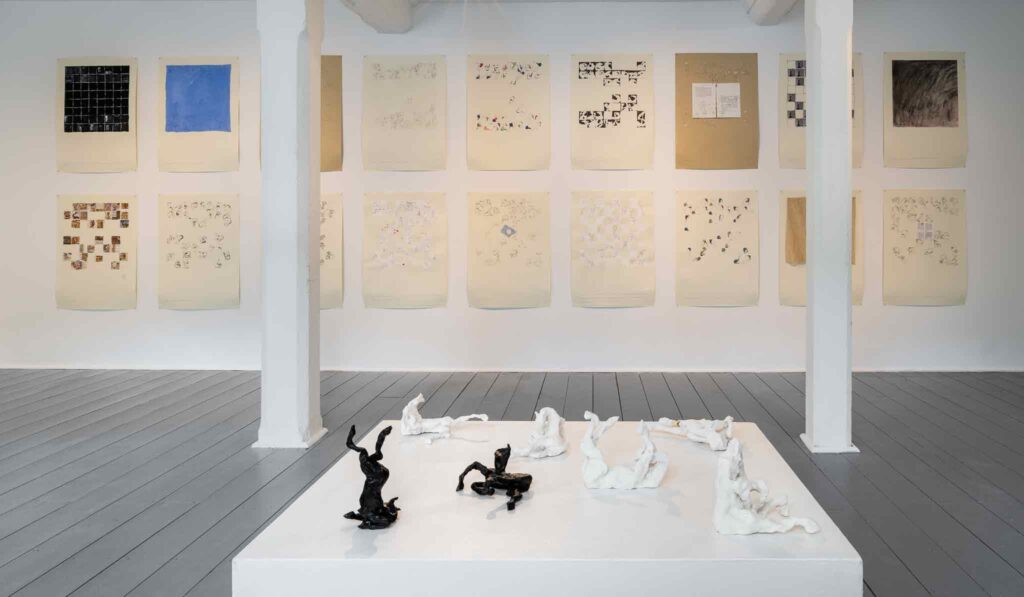The game of chess — long a preoccupation of Anna Barden’s — can be quite deceptive. We think of it as cerebral, the unfolding of a pattern with its roots in deep analytic thought. Rigorous thought, logical thought, driven by the inexorable ‘if this, then that’. Every move has a consequence, first immediate, then farther out ahead in the unfolding, a logic tree spreading and spreading. Every move is also a provocation, since the player is always asking ‘if I do this, then what might he/she do in response?’. The other is always present, every move is taken in full consciousness of that challenging presence. There is choice, and there is opposition.
But (and in this life isn’t there always a ‘but’…)
We can’t live like this, much as we might sometimes want to. We can’t live as if life is a cool game of chess. We move across the board in a series of hesitations and plunges, sometimes overthinking things, sometimes trusting (or not trusting) intuition, guesswork, blind faith.
The space between these contrasting perspectives is fertile ground for the artist to explore, since the artist always knows that it is not a question of ‘this, or that?” but of “this, and this’. The artist is not required to favour one mode of being over another; to choose the life thought carefully through, or the life consigned to the vagaries of chance and happenstance. The business of art is exploration, mind and heart in the game, sometimes one dominant, sometimes the other.
Like it or not we live in society and society is impossible without rules. Two sober, serious people facing each other over the squared chessboard might appeal as a metaphor for an ordered social existence. Yet, and the clue is in how the pieces move, the random and unexpected is provided for in the rules, the smooth and sometimes far-reaching glide path of the bishop, the jinkiness of the knight, the constraint on the king and the wild freedom of the queen, all these give the ground for tragedy, tragi-comedy, pure comedy. The wild and the wilful played out on a ruled and sober grid.
Anna Barden’s work negotiates the fraught territory that lies between assigned order and chaos — which is to say, formlessness, the impossibility of meaning. Her flower and plant paintings pitch colour and awkwardness, insistence, against the inherited neatness and order of tradition, her loyalty is to what Dylan Thomas called “the force that through the green fuse drives the flower”. The flower in the painting means to be itself in the same way as the flower in the garden border or the pot means to be itself. In her drawings, especially in her drawings of cats, the line is always urgent, uncomforting, each drawing records a struggle, each drawing is a struggle, not just to give the viewer ‘cat as depicted by the artist’, but to answer to the opponent on the other side of the board, the cat itself concerned only with being itself. And those tortured and vital horse sculptures? Think of the knight in the game of chess, the apparent waywardness of its moves, the way its awkward and disruptive way of appearing in unexpected places disrupts the smooth and fluent patterning moves of the other pieces. Think also, because Barden, always very conscious of language, is playing with a double meaning, of how check has a double meaning, the obvious meaning in the game, often precipitated by a knight’s move, but also referring to the rider’s checking of a horse, the slight pull back on the reins that steadies the animal for the imminent jump over an obstacle. Barden’s horses are recognisably horses — we have seen horses, we have seen representations of horses, we can read her sculptures as horses — but they are also horses that in their contortions, their expressing of themselves in modes of torture, speak to us of how will and consciousness can prevail, find identity, outside and sometimes despite the accepted norms.
Chess is not what it sometimes seems to be, and neither is life. Sometimes we play for desperate stakes, sometimes, in the need to prevail we rely on the unexpected move, the sideways jink and hop, and most of the time we are negotiating with the rules on a given field of play. This is neither a clinical nor a logical business, this business of living a life. As Pasternak says, “to live your life is not so simple as to cross a field”. or, for that matter, a chessboard. In her paintings, drawings and sculpture, Anna Barden squares up to this dilemma with courage and determination. I say, bravo! And thank you.
Theo Dorgan
